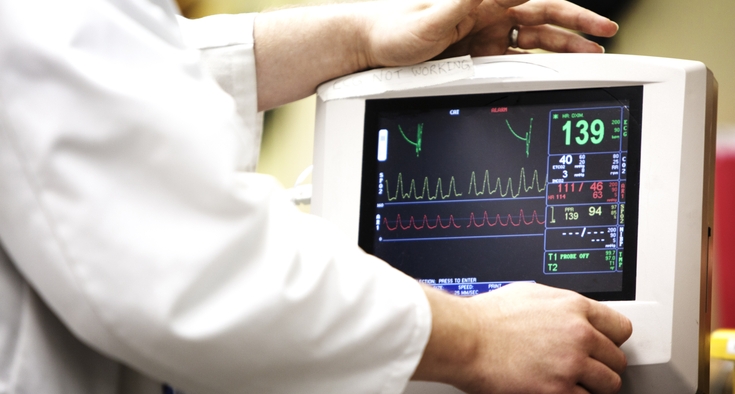The team at Novant Health Heart & Vascular Institute - Wilmington is offering patients with atrial fibrillation a leading-edge treatment that reduces the risk of stroke and offers better outcomes.
The team is performing left atrial appendage occlusion with the latest technology, which includes the Amulet device and the latest version of the Watchman device. Novant Health launched its left atrial appendage occlusion program about nine years ago and now the procedure is a regular part of treatment for certain patients with AFib.
One of the biggest concerns about atrial fibrillation is that it puts people at risk for having a stroke. Left atrial appendage occlusion is for those who cannot be on blood thinners long term to decrease the risk of stroke. In the coastal region, four implanters on the team are regularly performing this procedure. William Lance Lewis, MD, and Adam Pflum, MD, are interventional cardiologists trained in implanting both the Watchman FLX device and the Amulet devices. Keith Golden, MD, and Meena Rao, MD, are electrophysiologists trained in implanting the Watchman device.
Drs. Lewis and Rao and a team of Novant Health stakeholders started the left atrial appendage occlusion program around 2015. It has grown successfully as the technology has progressed. There is now a newer version of the Watchman, and a trial using the Amulet device has started.
Dr. Rao answered questions about left atrial appendage occlusion.
When should patients be referred for left atrial appendage occlusion?
Dr. Rao: “We’re happy to consult on any atrial fibrillation patient and see if they would benefit from any technology, whether that is ablation or a Watchman. Patients that are appropriate for left atrial appendage occlusion can take blood thinners short-term but are not good long-term candidates for blood thinners.”
Why do left atrial appendage occlusion candidates need to be able to be on blood thinners short-term?
Dr. Rao: “Patients do have to be on a blood thinner short-term around the time of the device implant. The devices take time to endothelialize, so being on a blood thinner short term prevents any clots from forming on the device. There are different anticoagulant strategies depending on the device implant, but in general, patients need to be able to take either a blood thinner and aspirin for 45 days, or aspirin and Plavix for 45 days. After that point, if the device has no leak around it and no clot on it, the patient takes aspirin and Plavix for six months after the procedure."
What is the pre-op process?
Dr. Rao: “Before the procedure, we get a CT scan of the left atrial appendage because the devices come in different sizes. We do want to make sure the appendage morphology is amenable to closure. Medicare requires dual physician acknowledgement that the patient is a good candidate for this procedure. Most patients will see one of our Watchman team of implanting physicians, which includes both the imaging physicians, as well as a second cardiologist, so there’s documentation that two physicians agree that this patient is an appropriate candidate.”
How is the procedure performed quickly and minimally invasively?
Dr. Rao: “The procedure is scheduled for two hours and recovery time is about four hours. Depending on timing, patients may be able to go home the same day as long as the procedure and recovery go smoothly. It is done minimally invasively through the right femoral vein. We go up to the left atrium through transseptal puncture in the interatrial septum and implant the device in the left atrial appendage.”
How does the team address the risk of peri-device leak?
Dr. Rao: “At 45 days after the device implant, we look at the device with a CT scan or a transesophageal echocardiogram to make sure that the device does not have a significant leak around it. If the patient is on direct oral anticoagulants and there’s no leak, we take them off the direct oral anticoagulant and they go to aspirin and Plavix afterward. If they have a significant leak around the device, we do have some options to plug those leaks with a coil.”
How does the team address the risk of device-related thrombus?
Dr. Rao: “While this is still a concern, we see less of this with the newer devices due to the design. The way the newer device is designed, it has lower risk of thrombus. We do image the devices at 45 days and one year to ensure there is no clot on them.”
Is there any ongoing maintenance with the Watchman?
Dr. Rao: “This is almost like a cardiac stent where we put it in the heart, and it stays in the heart.”
What outcomes are you seeing with the Watchman?
Dr. Rao: “The newer technology has made this procedure a lot safer, with less complications and faster procedure times. The majority of appendages now are able to be closed. Patients are now able to go home the same day after this procedure depending on the time of the procedure”
What’s your main goal with your patients?
Dr. Rao: “To ensure patients who can’t take blood-thinners long-term know they have another option to reduce the risk of having a stroke from atrial fibrillation."
To work with Novant Health Heart & Vascular Institute - Wilmington or to refer a patient, visit Heart & Vascular Institute | Wilmington Main or call 910-662-9500.





